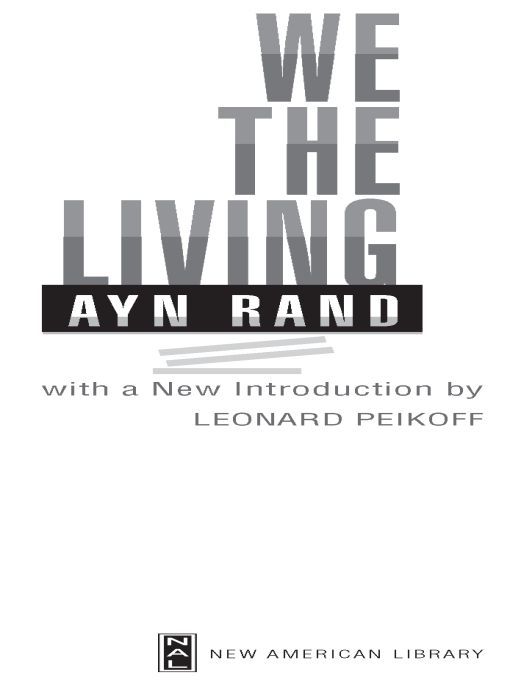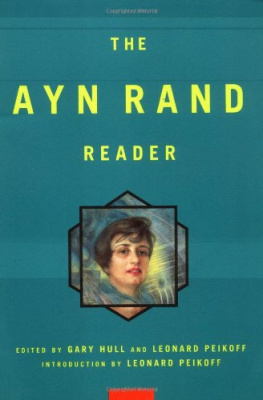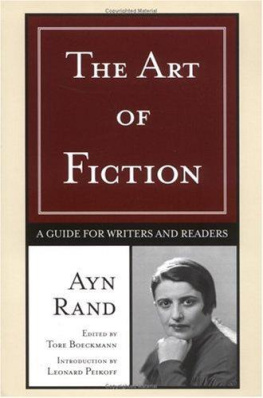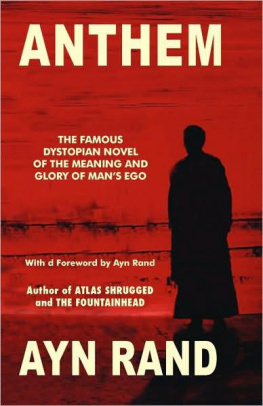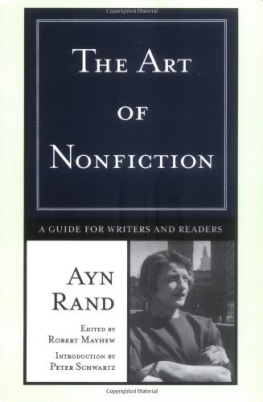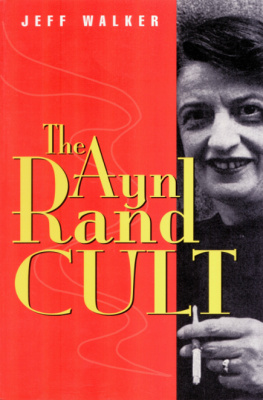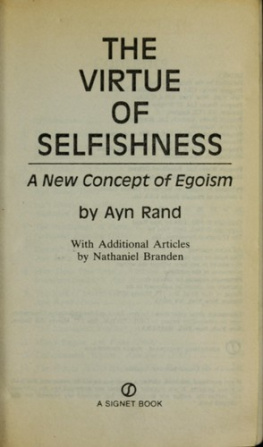Table of Contents
WE THE LIVING
published in 1936, was Ayn Rands first novel, and it has gone on to sell nearly two million copies in the mass market edition.
The theme of We the Living is one of the most significant of our timethe struggle of the individual against the state. It portrays the impact of the Russian Revolution on three human beings who assert the right to live their own lives and pursue their own happiness. It tells of a womans passionate love, held like a fortress against the corrupting evil of a totalitarian state, which demands from its citizens not independence but self-sacrifice.
Introduction
AS AYN RAND SAYS IN HER FOREWORD, We the Living is not a novel about Soviet Russia, which is only the backdrop of the story. The novels events, characters, and outcome are selected not by their relation to history, but to philosophy, which means that the books theme is universal. The theme is the evil of totalitarianism, a species of depravity not restricted to any country or century.
The basic cause of totalitarianism is two ideas: mens rejection of reason in favor of faith, and of self-interest in favor of self-sacrifice. If this is a societys philosophical consensus, it will not be long before an all-powerful Leader rises up to direct the faith and sacrifice that everyone has been extolling. His subjects cannot resist his takeover, neither by exercising their faculty of thought nor their passion for values, because these are the two priceless possessions they have given up. The end result is thought control, starvation, and mass slaughter.
Because of the Greeks commitment to reason, worldly happiness, and (relative) freedom, the above causal sequence was absent for centuries from the West. Then Christianity took over, demanding of menwith full consistency for the first timea life of faith and sacrifice. Although delayed by primitive technology, the result came soon enough: the infallible Pope, the plummeting life span, and the elimination of unapproved thought by the Inquisition.
The highest-ranking Christians in Europe were the first practitioners of Western totalitarianism. It was they who discovered the essence of a new kind of State, and offered it to the future as a possibility to consider.
At last, there was a Renaissance, and then the Wests long struggle toward the Enlightenment with its commitment to reason and the pursuit of happiness, and its ridicule of Christianity. The result was the freest country in history, America. It did not last, however, because nineteenth-century intellectuals, followers of Kant, rejected the ideas of the Enlightenment in favor of new forms of unreason and unselfishness. Within only a few generations, cause led to effect: totalitarians of every stripe sprang up, each claiming this time to be secular and scientific even as all worked diligently to reproduce the medieval model.
Totalitarian states differ in every detail, but not in their nature and cause. And in regard to details, what difference do their differences make? What does it matter to the victims if the infallible leader claims messages from the supernatural or from an unperceivable dialectic? If he demands sacrifice for Corpus Christi or for the proletariat? If the people are made to raise their hands in prayer or their feet in goose steps? If the killer troops wear black gowns or red shirts? If those out of favor are ripped open by knives in Spain or left to freezing starvation in the gulags? States like these often pose as enemies of one another, but the pose is tactics, not truth.
An eloquent example of the truth is what happened to We the Living under Mussolini. During World War II, the novel was pirated by an Italian film company, which produced a movie version without the knowledge or consent of AR. Because of its length, the picture was released in 1942 as two separate movies, Noi Vivi (We the Living) and Addio Kira (Farewell Kira). Both were enormous popular successes. The fascist government had approved the movie on the grounds that it was anti-Communist. But the public, like the director, understood at once that the movie was just as antifascist as anti-Communist. People grasped ARs broader theme and embraced the two movies, in part as a way of protesting their oppression under Mussolini. In a takeoff on the titles, people began referring to themselves as Noi Morti (We the Dead), and to Mussolinis economic policies as Addio, Lira. Five months after its release, the government figured out what everyone else knew and banned the movie. These events alone are eloquent proof that We the Living is not merely about Soviet Russia.
Nor is it merely about Europe or about the past. Witness the rise, in the United States today, of the Fundamentalist right aiming to outlaw ideas and values that conflict with the Bible; and the rise of the environmentalist left turning religious, invoking reverence for Natures Creator as the moral value mandating the end of capitalism; and, in more immediately practical terms, the eight-year rule of a born-again President, who shut down biological research he regarded as irreligious while claiming a message from beyond as a guide to foreign policy; and now his successor, of whom so far (2009) we know little, but whose campaign worked hard to prove that he is as devout as all the others. Will these developments, and many others like them, be united someday into an unstoppable religious juggernaut demanding of us the standard mind/self-emasculation, along with its standard political corollary? If it happens, its exponents are unlikely any longer to seize on economics or biology as their justification. As of now, it seems, we are headed back to the source: to the re-creation of medieval servitudeenforced by a much better-equipped secret police.
We the Living is a novel about the results of the freedom-erasing ideas you yourself probably accept. That is why it is relevant to you today. It is relevant because it tells you how to distinguish the poison the West is now greedily ingesting from the nourishment we desperately need. It is relevant because it is not about an ever-receding past, but about an ever-approaching future.
This book is not about your long-gone grandparents, but about your still-growing children.
Leonard Peikoff
Irvine, California
December, 2008
Foreword
I HAD NOT REREAD THIS NOVEL AS a whole, since the time of its first publication in 1936, until a few months ago. I had not expected to be as proud of it as I am.
Too many writers declare that they never succeed in expressing fully what they wished to express and that their work is only some sort of approximation. It is a viewpoint for which I have never had any sympathy and which I consider excusable only when it is voiced by beginners, since no one is born with any kind of talent and, therefore, every skill has to be acquired. Writers are made, not born. To be exact, writers are self-made. It was mainly in regard to We the Living, my first novel (and, progressively less, in regard to my work preceding The Fountainhead), that I had felt that my means were inadequate to my purpose and that I had not said what I wanted to say as well as I wished. Now, I am startled to discover how well I did say it.
We the Living is not a novel about Soviet Russia. It is a novel about Man against the State. Its basic theme is the sanctity of human lifeusing the word sanctity not in a mystical sense, but in the sense of supreme value. The essence of my theme is contained in the words of Irina, a minor character of the story, a young girl who is sentenced to imprisonment in Siberia and knows that she will never return: Theres something I would like to understand. And I dont think anyone can explain it.... Theres your life. You begin it, feeling that its something so precious and rare, so beautiful that its like a sacred treasure. Now its over, and it doesnt make any difference to anyone, and it isnt that they are indifferent, its just that they dont know, they dont know what it means, that treasure of mine, and theres something about it that they should understand. I dont understand it myself, but theres something that should be understood by all of us. Only what is it? What?

